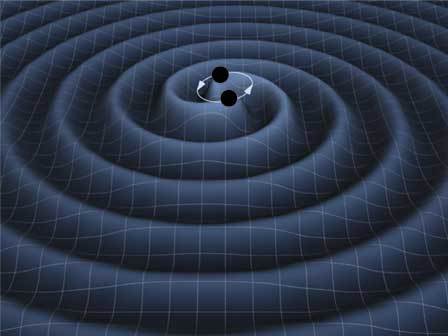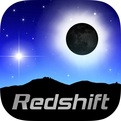Black Holes Merging
Black Holes In Star Clusters Stir Up Time And Space
 © LSC/NASA
|
An artist's representation of the burst of gravitational waves resulting from the collision of a colliding pair of black holes.
When stars are as close together as they are in clusters, then although still rare events, the likelihood of collisions and mergers between stars of all types, including black holes, is much higher. The black holes sink to the center of the cluster, where a core that is completely made of up of black holes forms. In the core, the black holes experience a range of interactions, sometimes forming binary pairs and sometimes being ejected from the cluster completely.
Now scientists assembled their own star clusters on a high-performance supercomputer, and then calculated how they would evolve by tracing the motion of each and every star and black hole within them.
According to a key prediction of Einstein’s General Theory of Relativity, black hole binaries stir the space-time around them, generating waves that propagate away like ripples on the surface of a lake. These waves of curvature in space-time are known as gravitational waves and will temporarily distort any object they pass through. But to date no-one has succeeded in detecting them.
In the cores of stars clusters, black hole binaries are sufficiently tightly bound to be significant sources of gravitational waves. If the black holes in a binary system merge, then an even stronger pulse of gravitational waves radiates away from the system.
Based on the new results, the next generation of gravitational wave observatories like the Advanced Laser Interferometer Gravitational-wave Observatory (Advanced LIGO) could detect tens of these events each year, out to a distance of almost 5000 million light years (for comparison the well known Andromeda Galaxy is just 2.5 million light years away).
Advanced LIGO will be up and running by 2015 and if the team from Bonn is right, from then on we can look forward to a new era of gravitational wave astronomy.
Sambaran, the lead author of the study, comments, “Physicists have looked for gravitational waves for more than half a century. But up to now they have proved elusive. If we are right then not only will gravitational waves be found so that General Relativity passes a key test but astronomers will soon have a completely new way to study the Universe. It seems fitting that almost exactly 100 years after Einstein published his theory, scientists should be able to use this exotic phenomenon to watch some of the most exotic events in the cosmos.”
Source: Royal Astronomical Society
Black Holes Merging
Black Holes In Star Clusters Stir Up Time And Space
 © LSC/NASA
|
An artist's representation of the burst of gravitational waves resulting from the collision of a colliding pair of black holes.
When stars are as close together as they are in clusters, then although still rare events, the likelihood of collisions and mergers between stars of all types, including black holes, is much higher. The black holes sink to the center of the cluster, where a core that is completely made of up of black holes forms. In the core, the black holes experience a range of interactions, sometimes forming binary pairs and sometimes being ejected from the cluster completely.
Now scientists assembled their own star clusters on a high-performance supercomputer, and then calculated how they would evolve by tracing the motion of each and every star and black hole within them.
According to a key prediction of Einstein’s General Theory of Relativity, black hole binaries stir the space-time around them, generating waves that propagate away like ripples on the surface of a lake. These waves of curvature in space-time are known as gravitational waves and will temporarily distort any object they pass through. But to date no-one has succeeded in detecting them.
In the cores of stars clusters, black hole binaries are sufficiently tightly bound to be significant sources of gravitational waves. If the black holes in a binary system merge, then an even stronger pulse of gravitational waves radiates away from the system.
Based on the new results, the next generation of gravitational wave observatories like the Advanced Laser Interferometer Gravitational-wave Observatory (Advanced LIGO) could detect tens of these events each year, out to a distance of almost 5000 million light years (for comparison the well known Andromeda Galaxy is just 2.5 million light years away).
Advanced LIGO will be up and running by 2015 and if the team from Bonn is right, from then on we can look forward to a new era of gravitational wave astronomy.
Sambaran, the lead author of the study, comments, “Physicists have looked for gravitational waves for more than half a century. But up to now they have proved elusive. If we are right then not only will gravitational waves be found so that General Relativity passes a key test but astronomers will soon have a completely new way to study the Universe. It seems fitting that almost exactly 100 years after Einstein published his theory, scientists should be able to use this exotic phenomenon to watch some of the most exotic events in the cosmos.”
Source: Royal Astronomical Society






